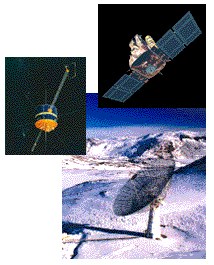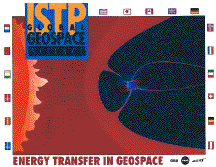Seeing the Invisible
Auroras are a visible sign of the magnetic mayhem in our atmosphere,
but beyond that, the human eye can't detect much of what we call
space weather. That's because most of the material flowing from
Sun to Earth is too small, too diffuse, or too dim-when measured
against the background of space or the brightness of the Sun-to
register in the visible portion of the spectrum.
For instance, since the corona is only visible to the naked eye during an eclipse,
scientists must use an occulting disk-which blocks out the light
from the solar surface to create an artificial eclipse-to detect
what the Sun is spitting into space. Some of the most important
recent advances in understanding and tracking coronal mass ejections
have come from cameras that photograph the corona and detect the
plasma of a CME as it heads toward Earth. In order to see the
invisible, space physicists rely on telescopes that detect visible
light, ultraviolet light, gamma rays, and X rays. They use
receivers and transmitters that detect the radio shock waves
created when a CME crashes into the solar wind (the equivalent
of a sonic boom in space). They employ particle detectors to
count ions and electrons, magnetometers to record changes in
magnetic fields, and cameras to observe the auroral patterns
over the whole Earth.
All of these instruments and many others are the tools of the
hundreds of scientists participating in the International
Solar-Terrestrial Physics (ISTP) program, a global effort to
observe and understand our star and its effects on our environment.
An armada of more than 25 satellites carry those instruments into
space, and together with ground-based observatories, they allow
scientists to study the Sun, the Earth, and the space between
them. Individually, the spacecraft contributing to ISTP act as
microscopes, studying the fine detail of the Sun, the solar wind,
and the boundaries and internal workings of Earth's magnetic shell.
When linked together with each other and the resources on the
ground, they act as a wide-field telescope that sees the entire
Sun-Earth environment.
The spacecraft of ISTP-principally, Wind, Polar, Geotail, and the
Solar and Heliospheric Observatory-allow physicists to observe all
the key regions of Earth's space. They study the interior of the
Sun, its surface and corona, the solar wind, and Earth's
magnetosphere, including the auroral regions and Van Allen
radiation belts. Orbiting as far as one million miles and as
close as a few hundred miles from Earth, the spacecraft of ISTP
make coordinated, simultaneous observations of the Sun and
activity in the magnetosphere. Working together with ground
observatories, these spacecraft can now-for the first time
ever-track CMEs and other space weather events from cradle to
grave. Someday, they might even be able to predict the arrival
and effects of CMEs.
|
Brought to you by the International Solar-Terrestrial Physics Program and NASA.
Comments/Questions/Suggestions:
Webmaster
Official NASA Contact:
ISTP-Project
/ NASA Home /
Goddard Space Flight Center Home
/



